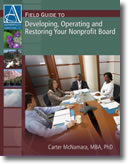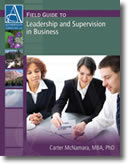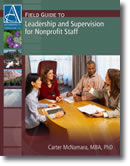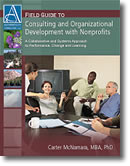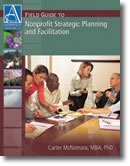Introduction
and Basic Overview
© Copyright Carter
McNamara, MBA, PhD, Authenticity Consulting, LLC.
Sections of This Topic Include
What is a Board of Directors? What Does a Board Look Like?
For-Profit (“Corporate”)
Boards Compared to Nonprofit Boards
Also consider
Related Library Topics
Learn More in the Library’s Blogs Related to This Topic
In addition to the articles on this current page, also see
the following blogs that have posts related to this topic. Scan
down the blog’s page to see various posts. Also see the section
“Recent Blog Posts” in the sidebar of the blog or click
on “next” near the bottom of a post in the blog. The
blog also links to numerous free related resources.
Library’s
Boards of Directors Blog
Library’s
Nonprofit Capacity Building Blog
What is a Board of Directors? What Does a Board Look Like?
A corporation, whether for-profit or nonprofit, is required
to have a governing Board of Directors. To explain, a corporation
can operate as a separate legal entity, much like a person in
that it can own bank accounts, enter into contracts, etc. However,
the laws governing corporations require that a corporation ultimately
is accountable to its owners (stockholders in the case of for-profits
and the public with nonprofits). That accountability is accomplished
by requiring that each corporation has a Board of Directors that
represents the stockholders or the public.
Members of a governing Board have certain legally required
(fiduciary) duties, including duties of care, loyalty and obedience
(some states and countries use different terms — for example,
in Canada, the duties of care and loyalty are often stressed).
For-profit Boards often are referred to as “corporate”
Boards, which really is a misnomer because both nonprofit and
for-profit corporations are required to have Boards — not just
for-profit corporations.
The phrase “Board operations” often refers to the
activities conducted between Board members and can include development
and enactment of Board bylaws and other Board policies, recruitment
of Board members, training and orientation of Board members, organizing
Board committees, conducting Board meetings, conducting Board
evaluations, etc. The phrase “governance” often refers
to the Board’s activities to oversee the purpose, plans and policies
of the overall organization, such as establishing those overall
plans and policies, supervision of the CEO, ensuring sufficient
resources for the organization, ensuring compliance to rules and
regulations, representing the organization to external stakeholders,
etc. The nature of Board operations and governance depends on
a variety of factors, including explicit or implicit use of any
particular Board model, the desired degree of formality among
Board members and the life-stage of the Board and organization.
Governing Boards can have a variety of models (configurations
and ways of working), for example, “working Boards”
(hands-on, or administrative, where Board members might be fixing
the fax one day and strategic planning the next), “collective”
(where Board members and others in the organization usually do
the same types of work — it’s often difficult to discern who
the Board members actually are), “policy” (where Board
members attend mostly to top-level policies), “Policy Governance”
(trademark of Carver Governance Design, where there are very clear
lines and areas of focus between Board and the CEO), etc. All
of these models are types of governing Boards.
Boards can have a broad range of “personalities.”
For example, Boards of large for-profit and nonprofit corporations
might be very formal in nature with strong attention to Parliamentary
procedures, highly proceduralized Board operations, etc. In contrast,
Boards of small nonprofit or for-profit corporations might be
very informal in nature. Some people believe in life stages of
Boards, including that they 1) start out as “working”
Boards where members focus on day-to-day matters in addition to
strategic matters, 2) evolve to “policy” Boards where
members focus mostly on strategic matters, and 3) eventually become
large, institutionalized Boards that often have small executive
committees and maybe many members some of which are “big
names” to gain credibility with funders or investors.
For-Profit (“Corporate”)
Boards Compared to Nonprofit Boards
People might be surprised to read that there are more similarities
between for-profit and nonprofit Boards than there are differences
— after all, both types of organizations are required to have
Boards because both types are corporations, thereby having similar
fiduciary responsibilities among members. Members of both types
of Boards must attend to the many activities involved in Board
operations and governance. Both types of organizations must conform
to rules and regulations for operations of corporations within
their states/provinces and countries, including for employment
laws and tax filings (each type of organization files different
types of federal tax forms). Thus, many of the topics included
throughout this overall Library topic on Boards are relevant to
both types of organizations.
Certainly, there are differences. For-profit Board members
often are paid, whereas nonprofit Board members usually are not
(except to be reimbursed for expenses). For-profit Board members
uniquely attend to decisions about dispersing profits to owners
(to stockholders), for example, in the form of stock equity and
dividends, whereas nonprofit Board members do not seek to maximize
and disperse profits to the owners — the owners of nonprofits
are members of the public. Nonprofit Board members often must
participate in robust fundraising by soliciting funds from individuals,
foundations, corporations and government entities. Nonprofits
corporations often enjoy certain tax advantages, including tax-exemption
(being able to avoid payment of certain taxes) and charitableness
(so donors can deduct donations from their taxes). To retain that
charitable tax status, Board and staff members of nonprofits must
refrain from exceeding certain limits of lobbying and self-dealing.
The following links depict a concise comparison of for-profit
to nonprofit corporations:
How Nonprofits Compare to For-Profits
For-Profit
and Nonprofit Boards: More Similarities Than Differences?
Nonprofit
and For-Profit Boards — a Comparison
Be sure to see the many general resources for Boards in the
USA and Canada, near the end of this Web page. Also see the closely
“Related Library Topics” and “Recommended Books”
referenced from the bottom of the page.
›Return to All About Boards of Directors
For the Category of Boards of Directors:
To round out your knowledge of this Library topic, you may
want to review some related topics, available from the link below.
Each of the related topics includes free, online resources.
Also, scan the Recommended Books listed below. They have been
selected for their relevance and highly practical nature.
Related Library Topics
Recommended Books


